Good morning everyone, and welcome back to the Mirror Gallery here on Hipsters of the Coast. Today is the fifth and final installment of the recurring series that fellow Hipsters writer Ryan Sainio and I embarked on last year, as we explore our favorite basic lands of each color.
Those of you returning to the column you already know this, but for anyone new, I like basic lands a whole lot. They are one of my favorite parts about deckbuilding, and I think they are one of the strongest storytelling components in the entire game. This article, like the Plains, Island, Swamp, and Mountain editions before it, came about after Ryan and I wrote an article about our favorite Planeswalker art (his is here and mine is here). It was also inspired by John Dale Beety’s 2018 article On Swamps, a series I very much wish could have continued, so make sure you click through to read.
Our goal is to highlight our favorites of each basic land type and give our audiences a little insight as to why. And for those who read the Swamp and Mountain articles, I have Urchin Colley back again to tell us about one of her favorite Forests too!
After pouring through Scryfall and the hundreds of different artworks and printings, I’ve found my favorite twelve Forests. I cut my teeth in Magic building Onslaught-block green decks, and it’s always been a color close to my heart. It’s time for the last article in the Mirror Gallery Curator’s Choice series: this is Finding Forests.
At a Glance: Basic Forest
Taking a look at Scryfall, there have been 230 unique illustrations of Basic Forest up to (but not including) Zendikar Rising, and those have been printed 614 different times between paper, promos, Magic Online, and Magic Arena according to the search engine. With all the digital reprints about now, these numbers are getting a bit muddy, but you get the idea. There’s a lot of them.
If ever there was a land type that was more than its title, it’s the basic Forest. Will we look at some actual Forests? Sure. Some big tress? Absolutely. But what follows are so much more; dense jungles, exotic foliage and fauna, and saplings of all shapes and sizes from planes across the Multiverse. Today we’ll look at the Forests through the trees (and if you didn’t think I’d make that pun: I mean, come on). Let’s begin:
Forest #278 (Ixalan) by Raoul Vitale
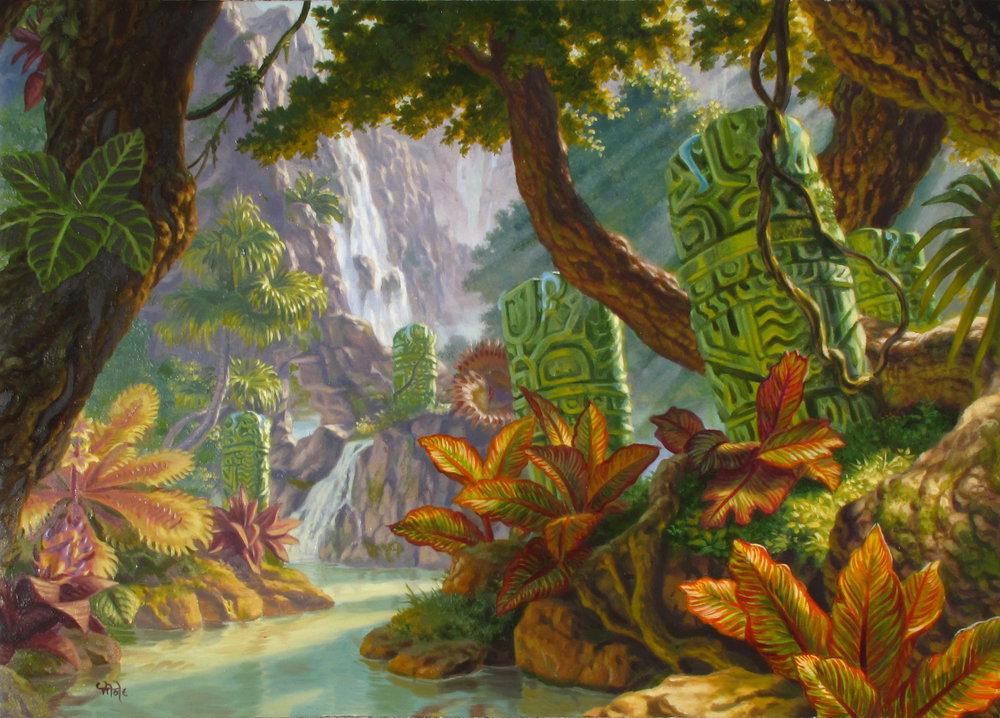
Forest #278 (Ixalan) by Raoul Vitale. Traditional.
Our first Forest takes us deep within the jungles of Ixalan, where Raoul Vitale takes us on a journey of color and depth through this once hidden world. The jade totems guide us down the river and through the image, as flashes of color pull our eyes left and right to attempt to take in the entirety of the beauty surrounding. The more I revisit the art of Ixalan the more I appreciate it; there’s so much to look at in this work, and I find something new every single time I take a look. It is one of my all-time favorite Forests, and will be for a long time.
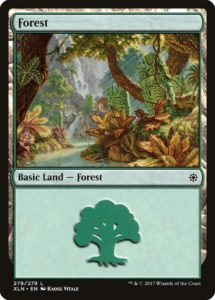
Forest #303-306 (Champions of Kamigawa) by Rob Alexander

Forest #303-306 (Champions of Kamigawa) by Rob Alexander. Traditional.
I opened so many packs of Champions of Kamigawa as a kid, and yet it wasn’t until I started writing about Magic art that I discovered that this work (and so many other lands) are polyptychic and panoramic pieces of artwork. These four cards by legendary landscape artist Rob Alexander are distinctly Kamigawa, representative of the large cedars of the Jukai Forest. Jukai literally means Sea of Trees translated from Japanese, which is something I just learned writing this article. Pretty cool, yeah?
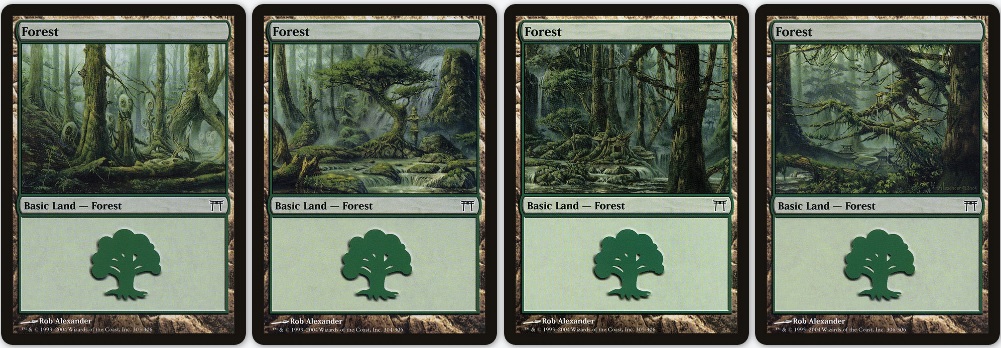
Forest #279 (Magic 2020) by Jim Nelson
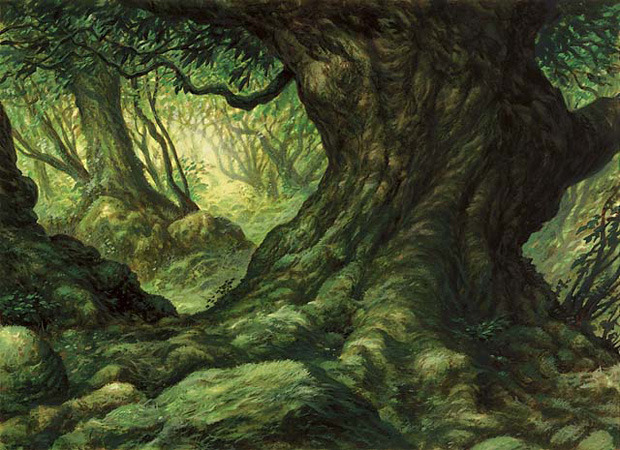
Forest #279 (Magic 2020) by Jim Nelson. Traditional.
Sometimes a Forest in Magic is a big beautiful tree with spectacular lighting; simple as that. My favorite among these is the tall timber given to us by Jim Nelson near a decade ago, and it’s been reprinted a fabulous eleven times, most recently in Core Set 2020. Again we get great depth, as the light in the background beckons us through the image. But my favorite element of this entire piece is all the different colors that went into making up the bark. Look close. It’s the realism in Imaginative realism at its best.
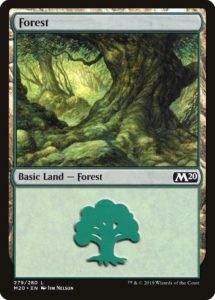
Forest #303 (Ravnica: City of Guilds) by Stephan Martiniere
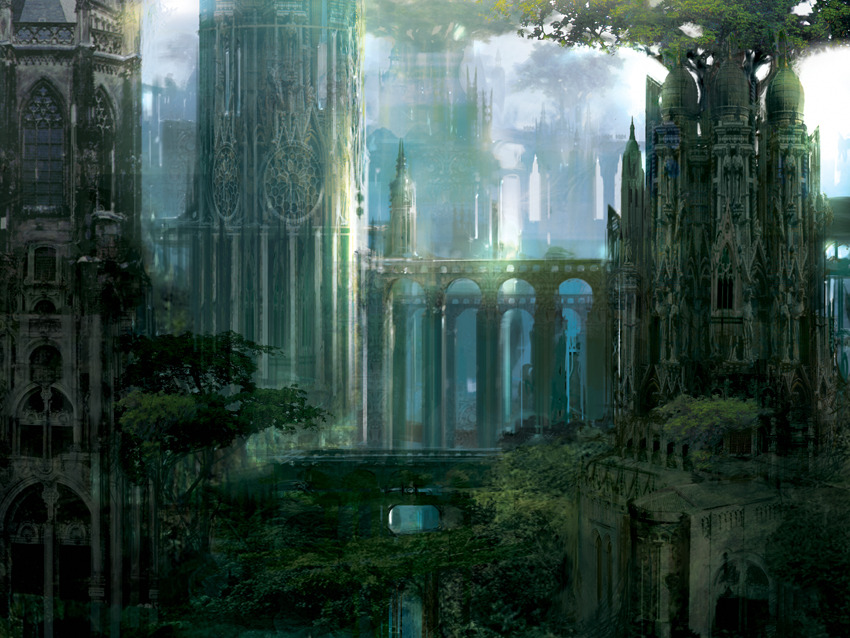
Forest #303 (Ravnica: City of Guilds) by Stephan Martiniere. Digital.
Martiniere’s entire Ravnica cycle was groundbreaking in terms of how we saw landscapes depicted in Magic: the Gathering, and this is the third of his I’ve included in this series. The original Ravnica: City of Guilds was a radical shift in what could and couldn’t be a Magic land, and opened up possibilities the game that just hadn’t been explored in its first ten years. There is a deep serenity amongst the sharply rendered spires of the Selesnya in this piece, and that dichotomy is what makes it so stunning.
I own the pencil sketch to this work. I had no idea it even existed until I met Stephan at last year’s Lightbox Expo, and I couldn’t pass it up. Have a look:
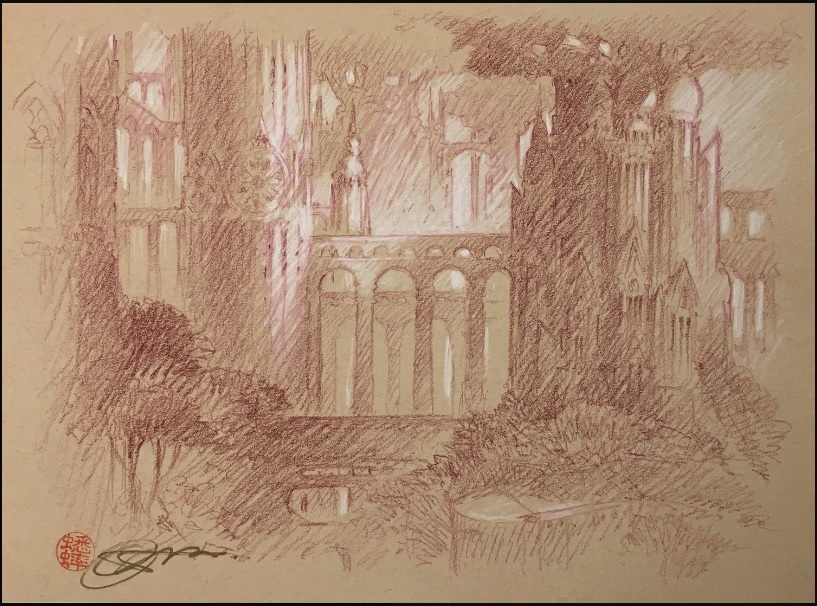
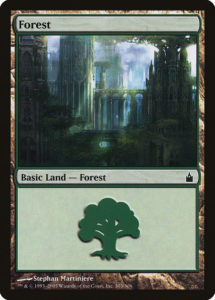
Forest #347 (Onslaught) by John Avon
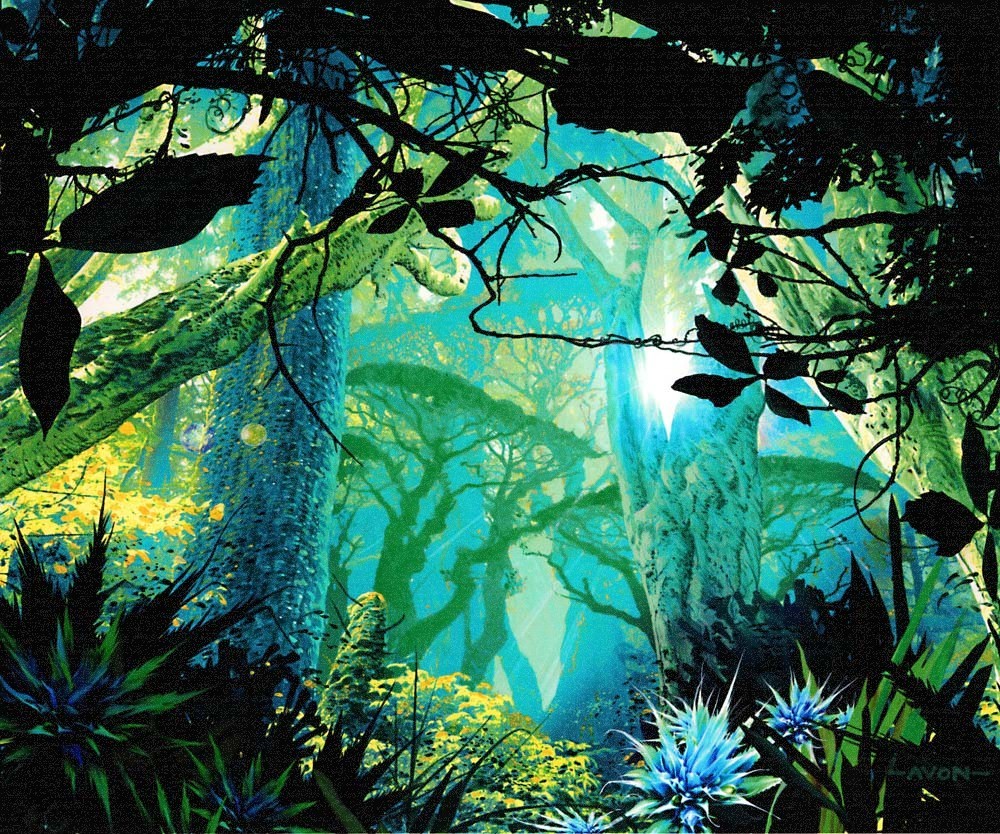
Forest #347 (Onslaught) by John Avon.
This forest is a serious nostalgia trip for me today, and remains one of my favorites after almost twenty years. I started playing right as Onslaught came out, and this was very much how I thought of all Magic forests: deep in the heart of Krosa, verdant and overgrown, untamed and wild. It was such a part of the story then too, what was happening, and that made the connection all the stronger. Just seeing this painting takes me back to my youth, and Avon’s landscapes from Onslaught will always be a part of the Magic story I tell in the future.
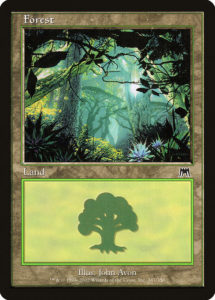
Forest #298 (Shadowmoor) by Larry MacDougall
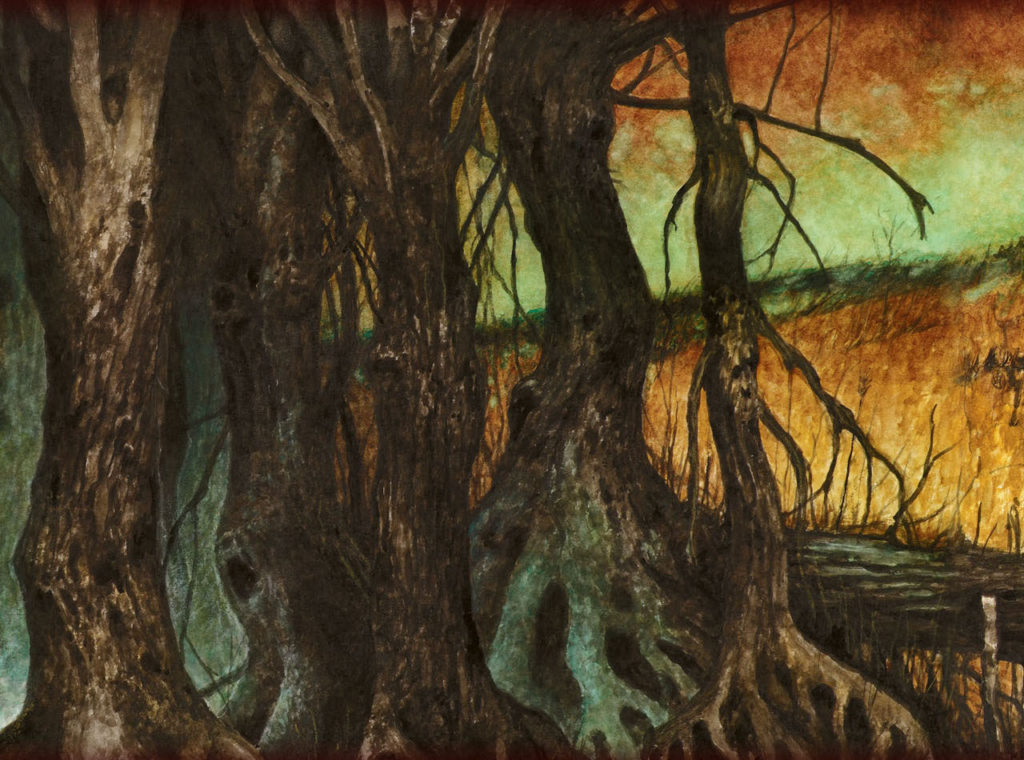
Speaking of nostalgia, this land by Larry MacDougall is an equal trip, but this time back to sophomore year of college. It is one half of a diptych (as all Lorwyn and Shadowmoor basic lands are), and the left side of a scene that shows the warping and transformation of a plane shrouded in darkness. You can see the underpinnings of MacDougall’s Magic work in his most recent project, the world of Gwelf; if he ever has time in the future, I’d love to see his style and artwork back in a future set.
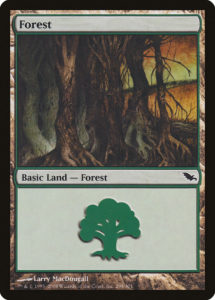
Forest #280 (Magic 2019) by Adam Paquette
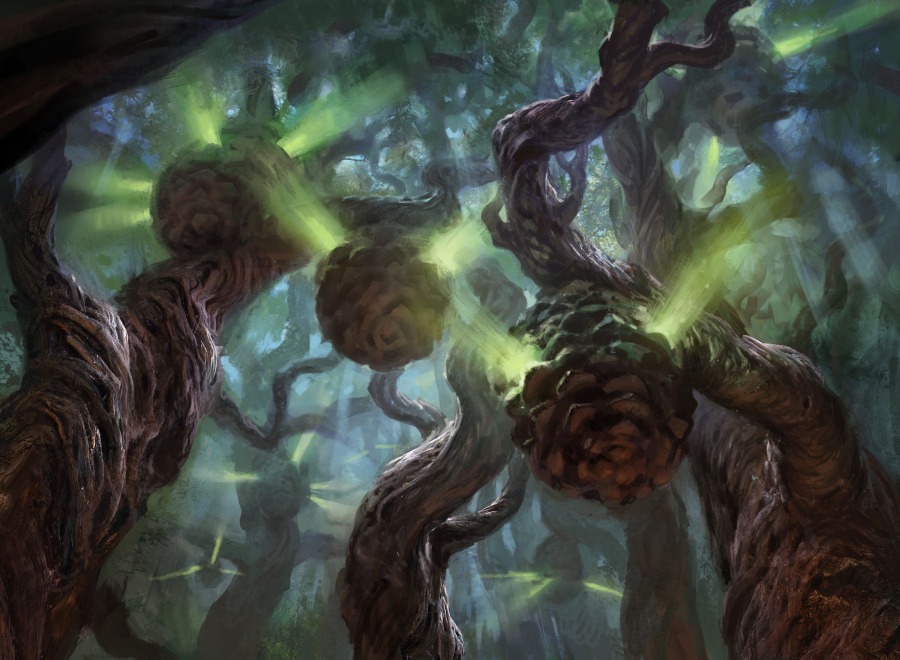
Forest #280 (Magic 2019) by Adam Paquette. Digital.
Listen closely, because this is a painting you can hear. As the green light cracks through these oversized pinecone structures, it echoes like the crunchy underfoot of an autumn hike in the woods. Can you hear it? Paquette’s landscapes all but speak for themselves, and he’s completed well over 100 of them for Magic even before his more than a dozen coming in Zendikar Rising. If you like his work as much as I do, stay tuned to this column: I’ve got a real treat coming in a few weeks.
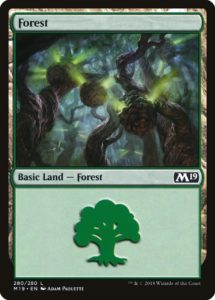
Forest #163 (Portal Second Age) by Quinton Hoover
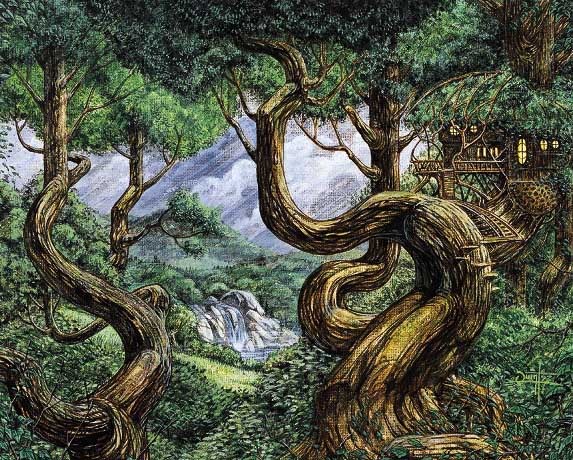
Forest #163 (Portal Second Age) by Quinton Hoover. Traditional.
There is almost always one Tolkein-reminiscent land in each of my articles, and today we go way, way back to Hoover’s “Curly” Forest, one of three he originally did for Portal Second Age. This land was published before my time in the game, but when I saw its original art for sale back when I entered that community, I was enamored. Hoover’s distinctive linework amongst this Hobbiton-meets-Fangorn scene is just classic Magic whether you started in 1993, 2003, or yesterday, and I sure would love to see it reprinted into foil. Secret Lair when?
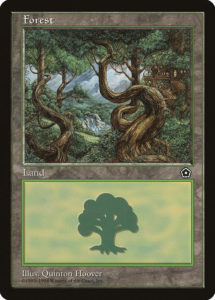
Forest #249 (Magic 2012) by Ryan Pancoast
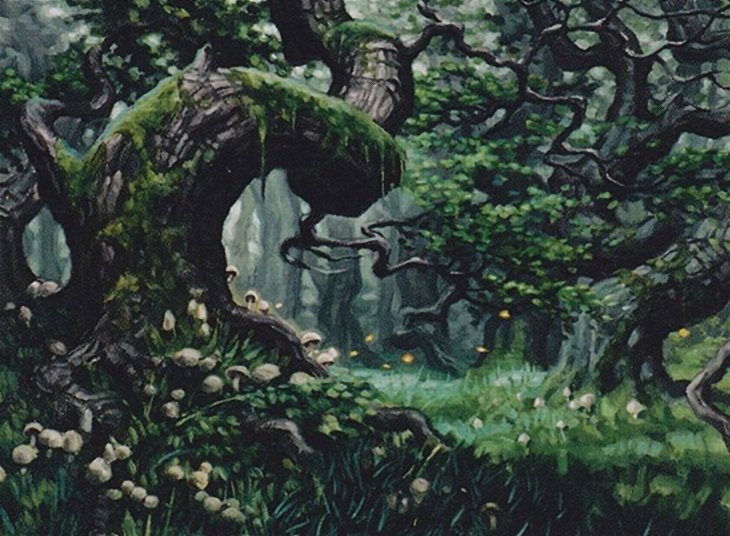
Forest #249 (Magic 2012) by Ryan Pancoast. Traditional.
Ryan Pancoast has done two basic lands for Magic, both a Plains and a Forest, and their inclusion are bookends this basic land series. This is one of his earliest works for Magic, and while he may not be known for his landscape work, that sure doesn’t mean he can’t do it. Look deeper into this paintings and you’ll see all sorts of things you miss at card size: mushrooms, moss that drips like water, and those same twisted and gnarled branches we see in some other classic Forests, like the one just before. I’ve got quite a few of these as I use them in my Pancoast Vintage Artist Constructed deck, and it will always be one of my favorites.
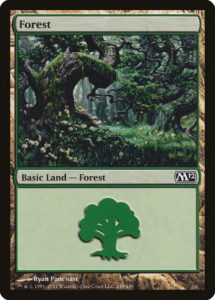
Forest #175 (New Phyrexia) by Mark Tedin
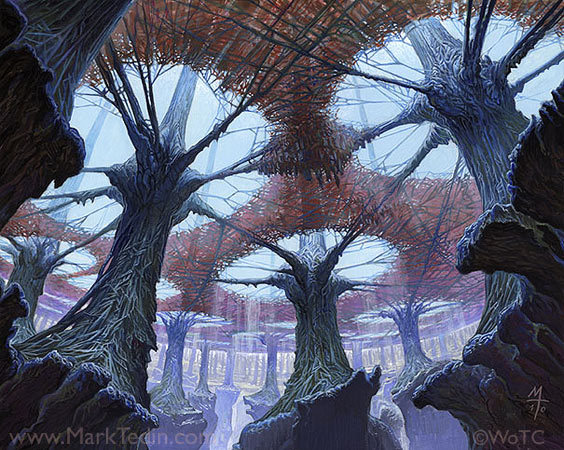
Forest #175 (New Phyrexia) by Mark Tedin. Traditional.
Have you ever seen this Forest in foil? I hadn’t until about a year ago. New Phyrexia came out when I was on a break from keeping up with new things, but this glimpse into an undone Mirrodin was just gorgeous. As much as I liked it I honestly didn’t know exactly what I was looking at, so I turned to the New Phrexia Planeswalker’s Guide that you can still find online. This new Tangle, which appears almost autumnal, are shoots of copper and verdigris that only resemble their organic counterparts. The scene is inanimate, yes, but its silence protrudes the card frame. Why does this look so good in metallic foil? Sure makes sense.
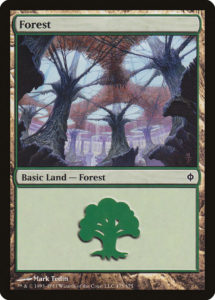
Forest #267 (Amonkhet) by Matt Stewart
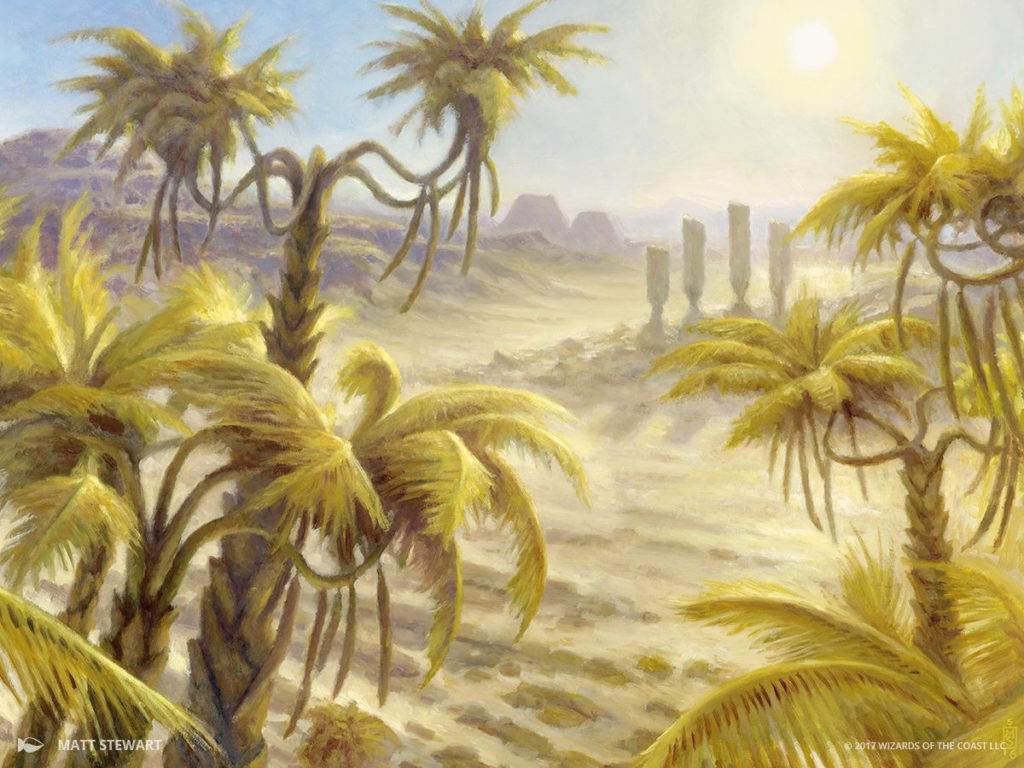
Forest #267 (Amonkhet) by Matt Stewart. Traditional.
Out of 180 cards total for Magic, this is it for Matt Stewart in terms of basic lands; a single Forest from Amonkhet that released a few years back. He is another where to see his prospect prowess, you must look into the backgrounds of some of his cards: Once Upon a Time, Nissa’s Pilgramage, and his two Planechase cards. If he’s ever not busy painting important legendary creatures, I’d love to see more lands from Matt sometime in the near future. Fingers crossed.
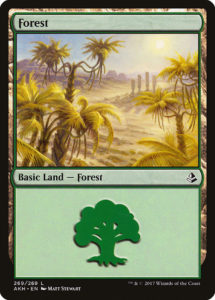
Urchin Colley’s “I LIke It”
Now for the third time, I’ve got fellow Hipsters author (https://www.hipstersofthecoast.com/author/ucolley/) Urchin Colley (https://twitter.com/hahyeahno?lang=en) back again to weigh in on her favorite Forest, and it’s one I didn’t really know prior to her entry. Let’s see what she picked!
Forest #331 (7th Edition) by John Avon
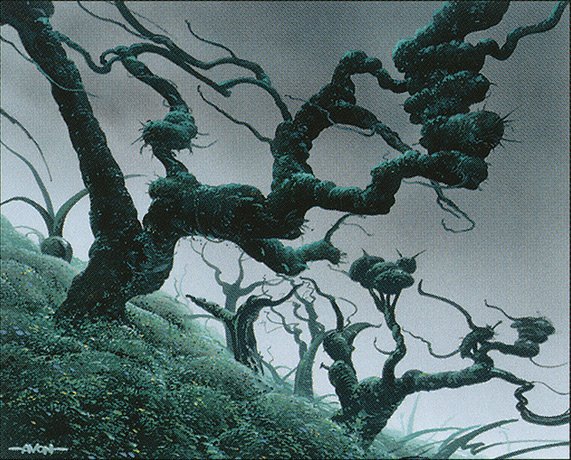
Forest #331 (7th Edition) by John Avon.
This was a hard choice. For me, there are more amazing basic forests than any other land type. I’ve chosen this 7th Edition John Avon Forest for what it says about the color Green.
The diagonal layout of this art gives it motion. The land could be sliding down and to the right, but the upright trees give it roots. Instead of a slide, I see mosses, grasses, and vines all spreading overland. The plant life works in unison to claim the land and grow its green mana. Even the forest’s own trees become covered, because they are part of a whole. This art is so quiet. The growth is inevitable. It’s powerful, but uncalculated. It’s exactly what it’s meant to be. I just love how profoundly green this humble Core Set forest is.
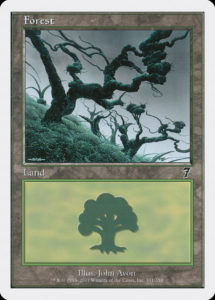
Wrapping Up
Well folks we made it, not just through the Forest but through the entire series covering Magic’s basic lands. These articles are a full on trip down memory lane for me, and reinforce that picking basic lands can be one of the most fun and fulfilling parts in all of Magic. It’s been such a joy to share these with you all.
As always, make sure you check out Ryan Sainio’s article of his favorites coming out today as well, about one hour from when this article is available. If we missed one of your favorites jump on over to Twitter and let myself or Ryan know, and while you’re there, we’d love to hear what you want to see next. Lands that make two colors? Three colors? Evolving Wilds? John Avon’s Greatest Hits? We want to hear from you!
If you want to do your own exploration and peruse all the basic lands of Magic, I’ll send you to two places. Scryfall (t:basic, unique:art) is fantastic for sorting by set and artist; and Basic Land Art, now with a fully functioning website, is perfect for themes, planes, and grabbing a good image. Rachel keeps Basic Land Art up to date with each new basic land and lots of different ways to search and group them, so make sure you drop by and say hello.
Zendikar Rising previews are in full swing, and I’ve got some artist interviews and a Grand Tour already underway. It should be an exciting couple of week ahead, so make sure you stay tuned here on Hipsters of the Coast for all your Magic art, both upcoming and otherwise. Stay well friends, and I’ll see you next time.
Donny Caltrider has been playing Magic since 2002 and collecting original Magic art since 2017. He has an M.A. in Museum Studies from Johns Hopkins University and enjoys telling stories about art, objects, and the intersection of fantasy with real-life. You can find him on Twitter talking about #mtgart, museums, and other #vorthos related goodness. Follow along and continue the conversation!

